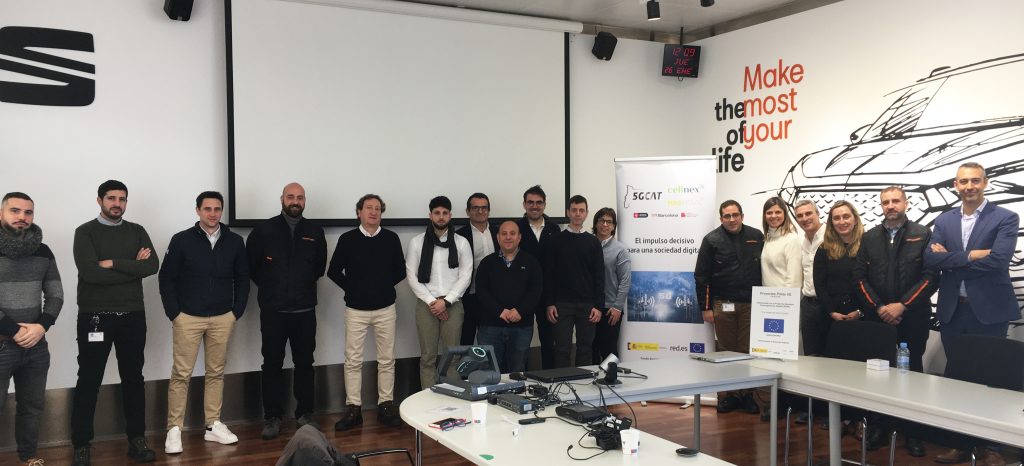- The 5G Catalunya pilot project, one of the 5G pilot development grants awarded by Red.es, has led a demonstration of this new technology at SEAT’s Martorell facilities
- This use case was made possible by Atos, Cellnex, Lenovo and Nae with the collaboration of SEAT and Accent Systems
The 5G Catalunya pilot project developed and validated an Industry 4.0 use case to track indoor assets, applying a hybrid solution combining UWB technology with advanced features of 5G technology. Four of UTE 5G Catalunya’s eight partners —Atos, Cellnex, Lenovo and Nae— participated in the pilot, with the collaboration of SEAT and Accent Systems.
The demonstration was carried out at SEAT’s facilities in Martorell, more precisely the furnace area of the electrified monorail waxing line in assembly workshop number 8, with the participation of representatives of Red.es and of the companies participating in the project.

The indoor mobile asset monitoring solution implemented at the SEAT production plant provides near real-time information on the position of the “octopuses” (electromechanical supports that transport the vehicle bodies along an electrified monorail).
Currently the octopuses’ position is monitored visually, but some areas are inaccessible for safety reasons, like the furnace area where the test was run. This difficulty in monitoring an automated assembly process could potentially lead to octopus crashes, possibly resulting in damage to the bodies being assembled or to the infrastructure itself.
The 5G Catalunya pilot project proposed a solution consisting of a localisation system based on UWB technology and a software platform to manage it using a private 5G network as a base, on which it is deployed.
The solution makes it possible to analyse the octopuses’ trajectories and to locate them with an accuracy of one to two metres, avoiding generating interference with other management and operations control systems by radiating the plant with complex infrastructure deployments. This enables visibility of octopus flows in areas whose location makes them inaccessible to operators, or where the massive and constant flow of automated mechanisms in certain areas makes it impossible to identify them visually. The system would also make it possible to monitor the number of times the octopuses are removed from the electrified monorail for repair or overhaul due to mechanical failure or maintenance. The availability of historical data makes it possible to visualise the trajectory of one or more octopuses at specific time intervals, as well as to identify areas where there is a build-up of octopuses, or where their speed could be increased to optimise the cycle time of one of the production processes.
Another benefit of the solution is that it makes it possible to identify anomalous situations and anticipate possible octopus collisions.
The 5G network in this use case is key to simplifying the network infrastructure, providing low latency, supporting the scenario with industrial mobility and being able to manage a high number of connected devices.
In the words of Jesús Benedicto, Head of Industry Unit in the Research & Innovation department at Atos, “the system implemented covers a need faced by more and more industries, i.e. to have information on the location of various assets to improve operational efficiency by effectively managing locations with high accuracy and reliability.”
Benedicto added that “the developed solution could also be applied to other use cases like tracking inventory and moving goods along a supply process in assembly lines to make operations more efficient and prevent errors. Similarly, it could also be applied to managing personnel safety: having information on workers’ location lets us know if someone may be at risk in a hazardous area, if they are isolated or injured, or if they have accessed restricted areas.”
At the technical level
Cellnex provided the 5G access network infrastructure with standalone configuration, to make it possible to transmit location data across the 5G network to an MEC, and then publish it to a software platform deployed in a public cloud (AWS) and represent it graphically in a near real-time layout.
Atos provided its expertise in private, standalone 5G networks and the technological solution to manage and monitor assets so that they can be administered, identified, assigned to multiple typologies and labelled. The solution covers storage of the positioning data provided by the real-time location system (RTLS), its subsequent processing and graphically representing the position of assets in a near real-time layout. Likewise, it is possible to visualise the routes of various assets at specific time intervals, access data history and manage alarms.
Accent Systems provided an RTLS solution based on UWB technology. The system consists of several UWB antennas or “anchors” and multiple active tags attached to the octopuses, which transmit information at predetermined time intervals. The system calculates the octopuses’ position by triangulating the signal emitted by the tags and measuring a tag’s distance from four anchors located in a specific area. This is based on the time-difference-of-arrival (TDoA), or the time that it takes a signal to cover a particular distance once emitted. Knowing a tag’s distance from four known points means its position can be triangulated with a high level of accuracy.
Once the position data has been transmitted and the triangulation-based calculation has been performed, the data is transmitted through a 5G CPE to a small cell 5G indoor radio unit, which receives the signal and transmits it via optical fibre to the MEC server in a Cellnex data-centre cabinet in the FDDI communications room of the SEAT facilities, where an application is deployed to transmit the data to a public cloud for storage, processing and visualisation.
The success of the use case is also attributable to Lenovo and its ThinkEdge technology for distributed processing. The capabilities of Intel Xeon processors installed in Lenovo ThinkEdge hardware were exploited to the maximum.
Specifically, the use case employed an edge architecture based on two-unit Lenovo SE350 servers integrated in cabinet streets (space-saving rooms, not dedicated IT rooms). This guarantees processing close to the data and enables smart optimisation of assets on the production line, allowing resources to be handled flexibly and improved agility in production systems in an industrial environment.
About 5GCat
5G Catalunya was one of the winners of the second call for funds to develop 5G pilots that was launched at the end of 2019 by Red.es —an entity of the Ministry of Economic Affairs and Digital Transformation— within the National 5G Plan. The initiative is co-financed by the European Regional Development Fund (ERDF).
The project consists of seven use cases aimed at developing solutions based on 5G technology for urban environments, specifically in mobility, remote education, the industrial sector, remote purchasing, audiovisual transmission, security and emergency management and connectivity in areas with high seasonal occupancy.
These seven use cases aim to drive digital transformation in various areas of people’s lives, helping to consolidate the implementation of a technological ecosystem that will undoubtedly act as a lever for development at both a social and economic level.

